Steel Boat Plans & Kits
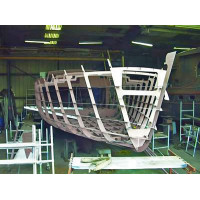
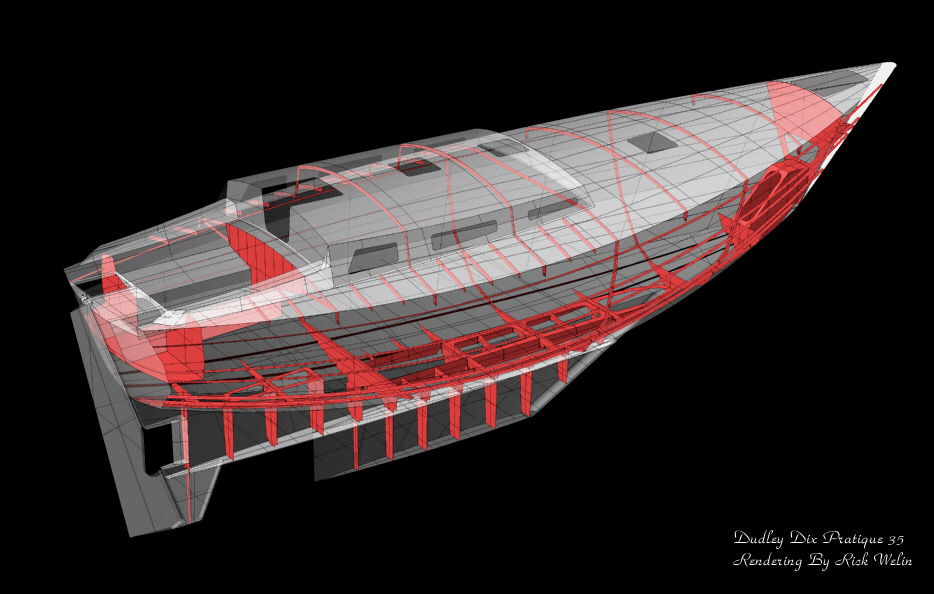 Over the past thirty years we have produced hundreds of designs and developed numerous building techniques from which over 20,000 boats have been built world wide, including power and sail pleasure boats, commercial and fishing boats. From this we have gained a depth of knowledge and experience allowing us to participate in advanced computer development for metal boats which has resulted in a range of sailboat designs which are now available in "flat pack" steel kit form for delivery world wide. All steel is "Grade A" with Lloyds Certificate and cut on an "NC" driven plasma-oxygen cutting machine for minimum distortion.
Over the past thirty years we have produced hundreds of designs and developed numerous building techniques from which over 20,000 boats have been built world wide, including power and sail pleasure boats, commercial and fishing boats. From this we have gained a depth of knowledge and experience allowing us to participate in advanced computer development for metal boats which has resulted in a range of sailboat designs which are now available in "flat pack" steel kit form for delivery world wide. All steel is "Grade A" with Lloyds Certificate and cut on an "NC" driven plasma-oxygen cutting machine for minimum distortion.
Radius chine kits are available as well as single and multi chine packages. These kits appear to provide the elusive link between computer-aided design and the latest fabrication techniques. Individuals and shipyards, particularly small enterprises can now benefit from modern cost-effective methods without major investment. With these techniques, you can obtain millimetre accuracy with great surface finish. To quote from one builder, Roger Lasham, in the UK, "I had completed the bottom plating which was only tack welded in place, yet when it rained overnight and the wind pulled the tarp aside allowing water to collect in the bow, it did not leak away so accurate was the fit".
Steel kits only require semi skilled labour for assembly and all steel plates, excepting 3mm, are shot blasted and primed with "Sigmaweld-mc" zinc rich primer which is especially formulated to allow the builder to weld the plates without destroying the adjacent prime coating. Another feature of this weld primer is that it does not give off toxic fumes, nor is there any weld "splatter". Each kit is "computer developed" and the parts are all nestled including all the plating so that you can easily assemble the hull, deck and superstructure in a very short time compared to conventional building and there is no wastage. All windows, doors, scuppers, prop and rudder tube holes are cut out and a pre-cut building cradle is supplied. Labour saving can be as much as 75% on conventional hull building times.
These metal kits are produced in such a manner that even an experienced builder will save many hours on the preparation work because the plates, frames, longitudinal and stringers and further necessary parts for the hull and superstructure are supplied pre-cut and accurate. No trimming is required. All the parts fit perfectly. On radius chine kits, the radius panels are rolled to the correct radius and you will only need to trim the edges after you have installed the rest of the hull plating which, does not need trimming. All plates have marking lines for positioning of frames, etc. and all plates are numbered and come with clear instruction and part drawings showing all items. Maximum plate size is 6 x 2 meter. Metal kits are available in steel or aluminium.
Note:-
We no longer sell metal powerboat kits, only sailboats.
For power boats please visit Bonito Boats. www.bonitoboats.eu
Forward bulkhead. By studying the cut out shapes on the plans beforehand, all parts are readily identifiable.

Floor webs in place showing lightening holes, notches for sole supports and stringers.
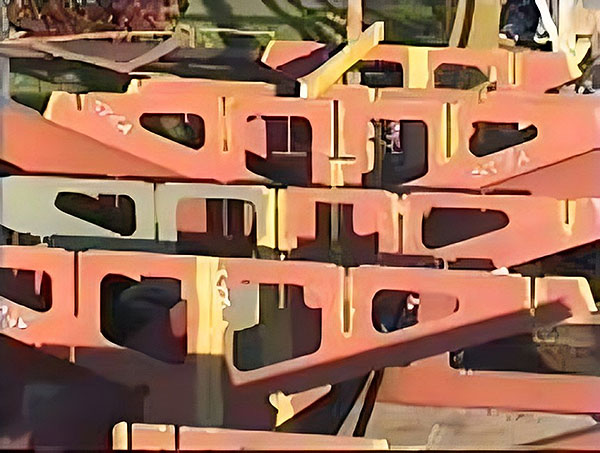
This is how it all started. The 284 separate pieces that make up the Roberts Spray 36 Version A
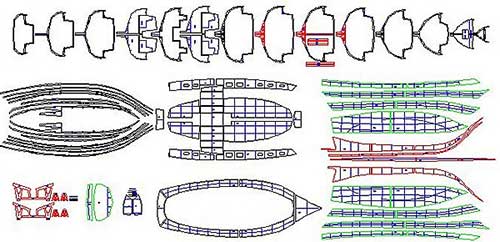
Bermuda 480 under construction. This hull, being built in Holland, has taken less than two weeks to reach this stage.
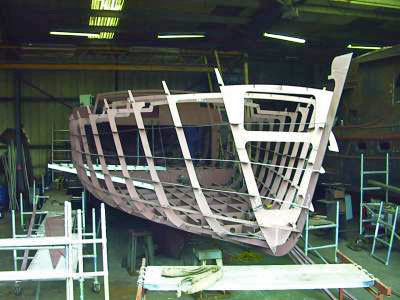
Kit Boat nested onto plates ready for cutting.
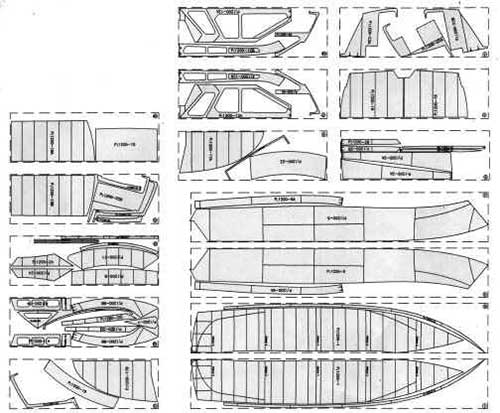
METAL KITS. Assembly instructions
INTRODUCTION:
Throughout these instructions the word metal may apply to either steel, aluminium or copper-nickel. There will be variations between the handling of the various materials and these will be drawn to your attention as necessary. You will need to read and absorb all these instructions BEFORE you start the assembly of your kit. These instructions are intended to introduce you to building from a kit but are NOT intended to replace good metal boatbuilding practice. If you are not already a competent welder then please seek assistance.
Few of you will understand (or want to know!) the huge amount of work that is required to turn any boat plan in to a cut-to-size boat kit. Every part has to exactly match that of its neighbour, the slots need to be exactly in the correct locations and everything must fit perfectly together to enable you to complete the assembly of the hull, deck and superstructure with the minimum of problems.
The first thing to realise is that the kit differs in many ways from the methods you would use to build a metal boat from scratch. Most metal boats built from scratch are built upside-down…most boats built from cut-to-size metal kits are built upright. Not only is this a more appropriate way to assemble the kit but it saves cost and inconvenience of having to turn the hull.
To make sure that you take notice of one very important piece of advice, we will state it here as well as at the appropriate time: You must tack weld the complete hull deck and superstructure together before you run any final welds. Failure to observe this advice will almost certainly ensure you will end up with an unfair boat requiring a considerable amount of filler.
RECEIVING YOUR KIT:
Depending upon your location or delivery arrangements you kit may arrive on a flatbed truck or in a container. You should be aware of these arrangements before the actual date of delivery so you can make the necessary preparations to receive your kit.
The kits are normally packed on pallet(s) and can be lifted off the transport using a small crane, front-end loader or similar equipment. You may find it more convenient to "drag" your kit from the truck or container using a pair or planks as a ramp. Once you have unloaded your kit you must make provision to keep it covered until assembly is underway.
You should go though the kit and identify each part or group of parts so you can store these in the order that they will be required. Due to the requirement of packaging for transport it is impossible for the kit manufacturer to stack everything in the order you will be using the various parts…you must take care of this. Later in this text we will suggest the order of assembling your kit so you will be aware of which parts will need at each stage. If you do not find a particular part at this stage there's no need to panic, there will be so many pieces that it will be easy for you to overlook one or two at this stage. If after several checks you find one or more parts missing then do contact us so that we may put the matter right.
STARTING ASSEMBLY:
The first item you will need is the setting up jig. The transverse profile jigs will be supported by the metal "castles" that come as part of your kit. The setting up jig is intended to get the assembly of your hull started and the jig is NOT INTENDED TO SUPPORT THE BOAT during the entire building process. After you have both sides of the bottom plates tacked together you should consider adding extra support and bracing to the structure.
Do not attempt to fully weld the plates into one length on the floor. The plate joins should be only tack welded in three locations, one weld at each of the ends of the join and one in the centre. These tacks should be no more than half inch or 12mm long. If you weld the plates on the floor you will end up with a "hard-spot" in the hull plating.
Some plates will need to be bevelled before tacking in place or you may prefer to make the bevels after you have tack welded the plates and just before running the final welds. In all cases good metal boatbuilding practices will prevail.
HULLS WITH LONG KEELS INCLUDING SPRAY TYPES:
The Spray and similar hulls are unusual in that the keel structure should be assembled at the same time as the bottom plating. Take care that you do not "squeeze' in the tops of the keel, use the webs as spacers. After you have positioned the bottom plates, the keel sections and the transverse profile jigs in their correct location you may start to tack weld the bottom plates to the keel sides.
SAILBOATS WITH FIN KEELS:
Sailboats with deep keels will have the keel installed after the hull is completed. The "canoe body" should be built from the bottom of the hull upwards in a similar manner used to assemble a powerboat hull. The webs will be arranged so you can later add the keel after raising the hull into the correct elevation. The idea of this method is to allow you to work on the hull deck and superstructure while the boat is at a lower level and thus more accessible. The exact method and order of assembly may depend on the availability of lifting equipment and your general working environment.
ALL HULLS:
Once you have set up the bottom hull plates and tacked these along the centreline together with installing the bottom sections of the frames, the remainder of the hull structure will grow upwards. The better equipped your workshop is with overhead lifting equipment the easier and more smoothly your job will proceed. We do recommend that you read Bruce's book METAL BOATS, which will answer many of the general metal boatbuilding questions that are sure to pop up as you proceed with your project. Also, please remember that we are only a phone, fax or email away and are only to happy to offer advice should you require it.
For more information Contact Us
